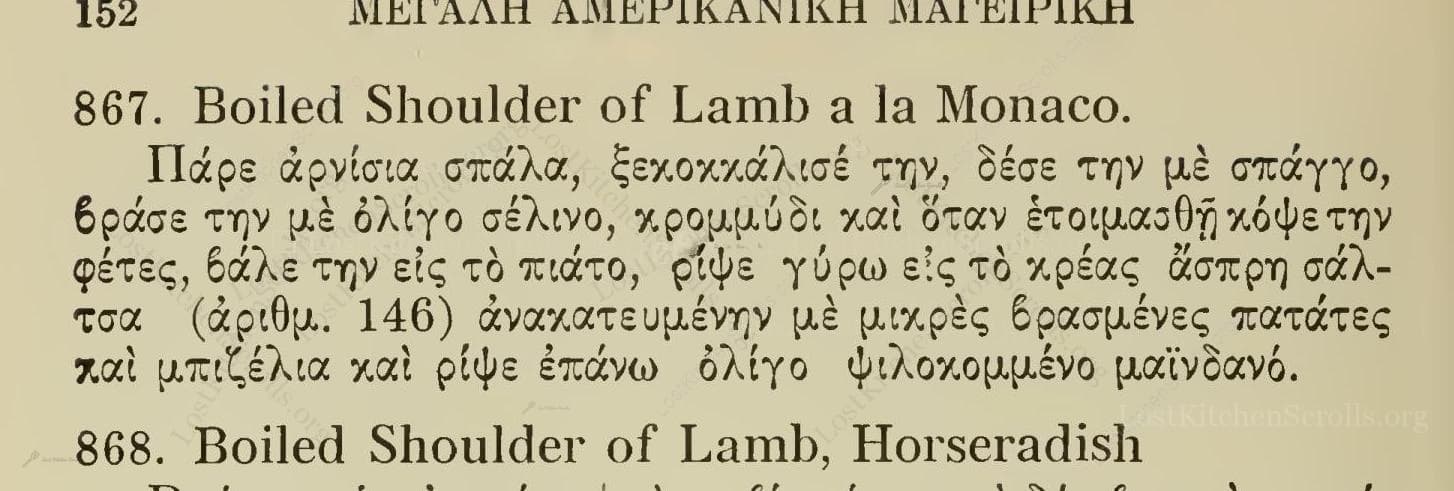Boiled Shoulder Of Lamb A La Monaco
"Boiled Shoulder Of Lamb À La Monaco"
From the treasured pages of Megale amerikanike mageirike dia mageirous kai oikogeneias
Written by Michael Gkines

Boiled Shoulder Of Lamb A La Monaco
"Πάρε ἀρνίσια σπάλα, ξεκοκκάλισέ την, δέσε την μὲ σπάγγο, βράσε την μὲ ὀλίγο σέλινο, κρομμύδι καὶ ὅταν ἑτοιμασθῇ κόψε την φέτες, βάλε την εἰς τὸ πιάτο, ρίψε γύρω εἰς τὸ κρέας ἄσπρη σάλτσα (ἀριθμ. 146) ἀνακατευμένην μὲ μικρὲς βρασμένες πατάτες καὶ μπιζέλια καὶ ρίψε ἐπάνω ὀλίγο ψιλοκομμένο μαϊνδανό."
English Translation
"Take a lamb shoulder, debone it, tie it with string, boil it with a little celery and onion, and when it is ready, cut it into slices, place it on a plate, pour around the meat a white sauce (no. 146) mixed with small boiled potatoes and peas, and sprinkle a little finely chopped parsley on top."
Note on the Original Text
The recipe is written in concise, almost telegraphic fashion, typical of early 20th-century cookbooks, which assumed a certain level of culinary knowledge from the reader. Instructions focus on essential steps, relying on the cook’s intuition and experience for finer points, such as precise measurements and times. Spelling and grammar echo the katharevousa Greek of the era, with some archaisms and direct, imperative instructions. Abbreviations and references to other numbered recipes (e.g., the white sauce) were common, emphasizing brevity and space efficiency in print.

Title
Megale amerikanike mageirike dia mageirous kai oikogeneias (1917)
You can also click the book image above to peruse the original tome
Writer
Michael Gkines
Era
1917
Publisher
Ekdotika Katastemata
Background
A sumptuous journey through early 20th-century Greek-American kitchens, this cookbook offers practical and time-tested recipes for savory dishes and delightful sweets—each crafted to suit the American system, yet infused with Greek tradition. A perfect companion for both family cooks and aspiring chefs.
Kindly made available by
Internet Archive
This recipe hails from the early 20th-century Greek cookbook 'Megale amerikanike mageirike', published in New York in 1917 by Michael Gkines. The cookbook introduces Greek home cooks and professional chefs to practical and tested recipes for both everyday and special-occasion dishes, blending traditional Greek flavors with emerging trends and techniques inspired by the American culinary system. During this period, many Greeks were living in diaspora, especially in America, and sought to preserve their culinary heritage while embracing new methods and ingredients available in their adopted homeland. The use of classic sauces, careful roasting or boiling, and presentation with fresh vegetables reflects a cosmopolitan yet nostalgic approach to food.

Historically, this dish would have been prepared using a sturdy butcher’s knife for deboning, a larding needle or kitchen twine for tying the meat, a large stock pot for boiling, and a slotted spoon or ladle for skimming. Potatoes and peas would be boiled in separate saucepans or perhaps together, and the white sauce made in a small, heavy-bottomed pan. A sharp knife for slicing and a wide platter for serving would complete the necessary kit.
Prep Time
20 mins
Cook Time
1 hr 45 mins
Servings
6
We've done our best to adapt this historical recipe for modern kitchens, but some details may still need refinement. We warmly welcome feedback from fellow cooks and culinary historians — your insights support the entire community!
Ingredients
- 1 lamb shoulder (about 3.3–4.4 lb), deboned
- kitchen twine (for tying)
- 2 celery stalks
- 1 medium onion
- water (enough to cover meat)
- about 10.5 oz small potatoes, peeled and boiled
- 5.3 oz peas, boiled
- 2 cups white sauce (Béchamel or similar)
- 1 tablespoon fresh parsley, finely chopped
Instructions
- Take a whole shoulder of lamb (about 3.3–4.4 lb), carefully debone it, and tie it into a neat roll with kitchen twine.
- Place the tied lamb in a large pot with enough water to cover, adding a few celery stalks and one medium onion, peeled and halved.
- Bring to a gentle simmer, skimming any foam, and cook for about 1.5–2 hours until the meat is tender.
- When ready, remove the lamb, slice it into even pieces and arrange on a serving platter.
- Around the sliced meat, spoon a white sauce (see recipe for White Sauce, number 146), which has been mixed with small boiled potatoes and peas.
- Finish the dish by sprinkling a little finely chopped parsley over the top before serving.
Estimated Calories
530 per serving
Cooking Estimates
You will need about 20 minutes to prepare the ingredients and workspace, such as deboning, tying the lamb, and chopping vegetables. The lamb simmers for about 1 hour and 45 minutes until tender. This dish serves about 6 people, and each serving has around 530 calories.
As noted above, we have made our best effort to translate and adapt this historical recipe for modern kitchens, taking into account ingredients nowadays, cooking techniques, measurements, and so on. However, historical recipes often contain assumptions that require interpretation.
We'd love for anyone to help improve these adaptations. Community contributions are highly welcome. If you have suggestions, corrections, or cooking tips based on your experience with this recipe, please share them below.
Join the Discussion
Rate This Recipe
Dietary Preference
Main Ingredients
Culinary Technique
Occasions

Den Bockfisch In Einer Fleisch Suppen Zu Kochen
This recipe hails from a German manuscript cookbook compiled in 1696, a time whe...

Die Grieß Nudlen Zumachen
This recipe comes from a rather mysterious manuscript cookbook, penned anonymous...

Ein Boudain
This recipe comes from an anonymous German-language manuscript cookbook from 169...

Ein Gesaltzen Citroni
This recipe, dating from 1696, comes from an extensive anonymous German cookbook...
Browse our complete collection of time-honored recipes



